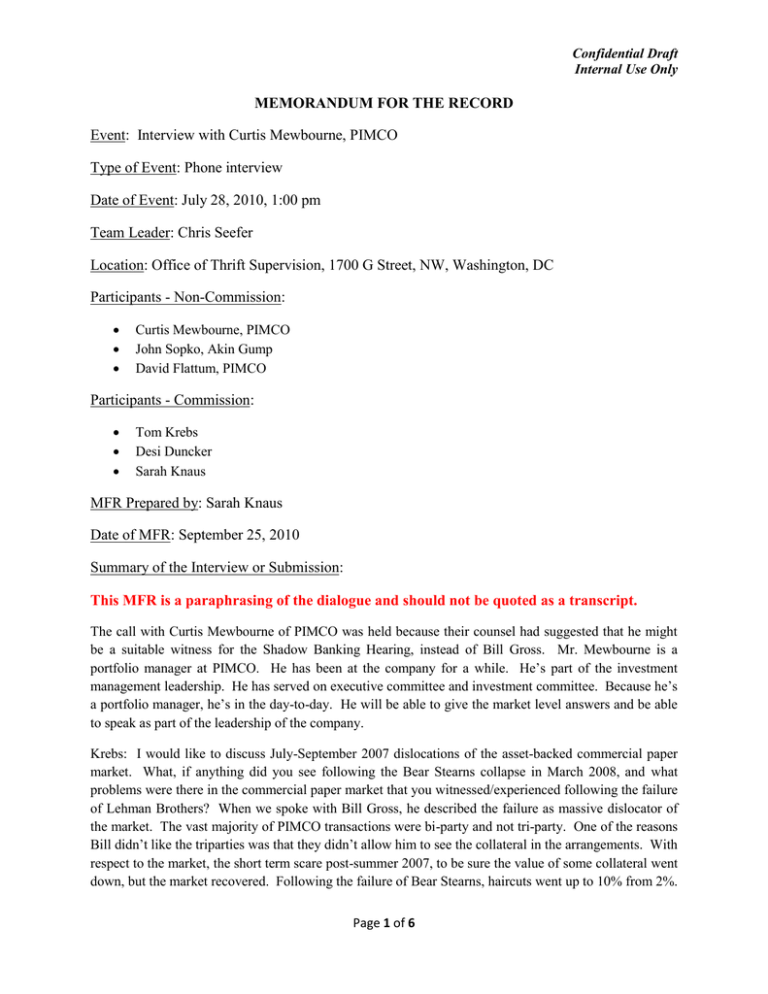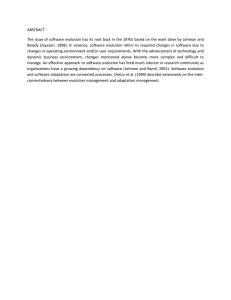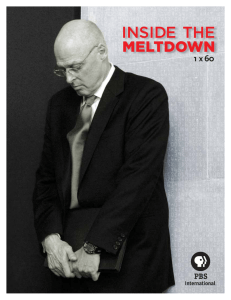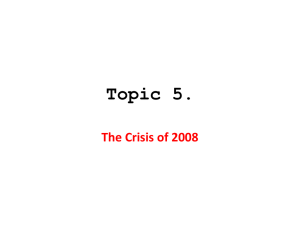MEMORANDUM FOR THE RECORD Event: Interview with Curtis Mewbourne, PIMCO
advertisement

Confidential Draft Internal Use Only MEMORANDUM FOR THE RECORD Event: Interview with Curtis Mewbourne, PIMCO Type of Event: Phone interview Date of Event: July 28, 2010, 1:00 pm Team Leader: Chris Seefer Location: Office of Thrift Supervision, 1700 G Street, NW, Washington, DC Participants - Non-Commission: Curtis Mewbourne, PIMCO John Sopko, Akin Gump David Flattum, PIMCO Participants - Commission: Tom Krebs Desi Duncker Sarah Knaus MFR Prepared by: Sarah Knaus Date of MFR: September 25, 2010 Summary of the Interview or Submission: This MFR is a paraphrasing of the dialogue and should not be quoted as a transcript. The call with Curtis Mewbourne of PIMCO was held because their counsel had suggested that he might be a suitable witness for the Shadow Banking Hearing, instead of Bill Gross. Mr. Mewbourne is a portfolio manager at PIMCO. He has been at the company for a while. He’s part of the investment management leadership. He has served on executive committee and investment committee. Because he’s a portfolio manager, he’s in the day-to-day. He will be able to give the market level answers and be able to speak as part of the leadership of the company. Krebs: I would like to discuss July-September 2007 dislocations of the asset-backed commercial paper market. What, if anything did you see following the Bear Stearns collapse in March 2008, and what problems were there in the commercial paper market that you witnessed/experienced following the failure of Lehman Brothers? When we spoke with Bill Gross, he described the failure as massive dislocator of the market. The vast majority of PIMCO transactions were bi-party and not tri-party. One of the reasons Bill didn’t like the triparties was that they didn’t allow him to see the collateral in the arrangements. With respect to the market, the short term scare post-summer 2007, to be sure the value of some collateral went down, but the market recovered. Following the failure of Bear Stearns, haircuts went up to 10% from 2%. Page 1 of 6 Confidential Draft Internal Use Only These haircuts stayed at 4-5%. Haircuts on mortgage pools went as high as potentially 30%. Things really got ugly after Lehman failed, haircuts went way up, and lots of paper could not be financed. A lot of Lehman paper was involved in fails to deliver. Lehman’s matchbook fell over. Everyone felt counterparty risk was very high. The market was just not functioning and there were no commercial paper buyers. Based on that discussion, I’ve prepared questions that you could answer. Mewbourne: I’d be happy to make a few comments on Bill’s analogy. In terms of that chronology, if you think about it, in the context of the banking and shadow banking system, it’s one of the shadow banking system unraveling. The shadow banking system is a non-regulated set of entities that are acting like banks without regulations. Shadow banking can be thought of as structured investment vehicles or conduits –entities set up to borrow money short-term, invest in securities longer term. They were able to borrow short term because the securities investing in were AAA rated. They borrow in money markets and lend in areas that formally were served by the regular banking system. The money went to mortgages and commercial mortgages. Shadow banks were playing a larger roll and were lending to untraditional homeowners, and to subprime mortgages. The investment banks were an example of shadow banks. They were not regulated in the same way as commercial banks and did not have a lender of last resort, even though the FRB had to become their lender of last resort. In the summer of 2007, when the Bear Stearns hedge funds began to suffer losses, and because of the way they financed, Bear had to post collateral into those funds. The way I would describe it, at the time, this seemed to be rather isolated incident. Even Bernanke said it was contained. It’s obvious in retrospect, but at the time it was much less obvious. By the time this began to accelerate, when Bear was no longer able to finance, its customers began to leave (hedge funds out of prime brokerage, etc.) A deleveraging and run happened on Bear, and the Treasury Department and JPMorgan had to step in and save them. Even with new policies like the primary dealer credit facility, it still wasn’t enough. From March until the default of Lehman, there was a rapid and continued deleveraging of the shadow banking system. It’s a story of a snowball that kept growing. Krebs: What was PIMCO’s experience in repo and this market? Mewbourne: We’re an investment manager of over $1 trillion. Most of our investors are pension funds for companies (our clients represent half of the Fortune 500), state pension funds, mutual funds for individuals. The PIMCO Total Return Fund is the largest in world. It’s run by Bill Gross and is relatively conservative. Our core activity is in investing in relatively stable securities. Repo and money markets are really a small part of our business. We use this for a mutual fund or Fortune 500 company that may have a cash balance in it, we will invest it in commercial paper or the repo market through secured loans, usually backed by Treasury bonds. Krebs: You have some accounts designed for leverage where you buy bonds and lend the bonds out to obtain more money for more bonds? Mewbourne: Within our company, we have about $5 billion, in context of overall business. It’s less than .5%. We do have some strategies that use the repo markets to borrow and lend. Krebs: You buy the bonds and lend the bonds out in reverse repos or forward transactions. Why does PIMCO engage in these? Page 2 of 6 Confidential Draft Internal Use Only Mewbourne: The main reason that we would use these markets is when we have cash balances, we would use a repo market because we can loan the cash out and get the security in. We hold the collateral, which is usually Treasury bonds. This is usually safer than loaning commercial paper. We have a low interest rate, but we want to be conservative. Krebs: Are these typically short term? Mewbourne: Yes, most repo markets are very short. They can go day to day (overnight) or longer, usually days or weeks. Krebs: Does PIMCO do tri-party or bi-lateral arrangements? Mewbourne: We do not do tri-party repo. The way I think of it is that we’re a very large institution. We manage money for 3000+ clients. We have a large team of people handling money, and have a good platform. The tri-party is use when you don’t have that operational platform. We don’t need to do that. Krebs: Tell me about the repo market conditions following Bear Stearns in March 2008. Mewbourne: Going into that event, there were some big dislocations in the repo market. The securities market and repo market are large. Because Bear didn’t have deposit, they had to get financing and get them from other securities. Bear can borrow debt from the market, get commercial paper, and issue bonds. In a lot of cases they can go out and borrow if they pledge securities that they own. Krebs: Bill spoke of virtual permanent changes post-Bear Stearns’ collapse. He mentioned that PIMCO was concerned about the margins required in these deals. Mewbourne: We’ve been talking about this secured lending – it’s worth going down another layer of detail. It’s almost secured through collateral, but the haircuts leave a little bit of exposure to the counterparty. Under a 1% haircut, a counterparty would say that they’re 99% secured and feel comfortable. When Bear started to look like they could not repay, the banks started to require larger haircuts from each other. When they try to protect themselves at the same time, it creates a vicious cycle that causes more and more deleveraging. In advance of Bear, you saw dislocation of market. After the Bear intervention, it started to slow down because the FRB and JPMorgan were involved. I remember in the derivatives markets, many of the dealers stopped dealing with each other. Jamie Dimon came out and said that they would continue trading with all of those banks. Within the PIMCO investment committee, we said that Dimon was obviously working closely with market participants and it was a signal that the policy makers were likely to step in. Those types of measures did help calm down the financing and repo markets. It turns out that the snowball had gotten too big and the hill was too steep, so these measures were not enough to stop de-leveraging. Krebs: Was Dimon talking about the novations that were occurring when people didn’t want Bear as a counterparty anymore? Mewbourne: Yes. As you can imagine, when there are transactions occurring, they are occurring over telephone. Money and documents have not been exchanged. There is risk between when you make an agreement and when you have the money and documents signed. It’s called daylight signing. The idea of Page 3 of 6 Confidential Draft Internal Use Only transferring a contract from one entity to another is a novation. The ability to novate ceased to exist and was a key event in the demise of Bear Stearns. Krebs: Were you aware that Goldman had said they would not be a counterparty to Bear Stearns? Mewbourne: I had heard, I wouldn’t want to mis-remember something, but certainly for those days in advance of Bear, you had many of the individual departments at investment and commercial banks talk about who they would and wouldn’t deal with. It was chaotic in terms of who is dealing with whom. Krebs: If you’re in a repo transaction and are collateralized, why are you concerned about counterparty risk? Mewbourne: This is a key part of the crisis. The market was starting to think that the AAA securities were not AAA. People were beginning to think that they don’t have as good of securities and are not covered enough by the haircut, you see the rise in the number of securities that not actually AAA. Duncker: The realization that many securities were not AAA, was it during the time or after the fact? Mewbourne: Broadly speaking, the rating agencies were lagging the financial markets in terms of risk analysis. It wasn’t the case that they identified a forward looking risk, it was that they identified concerns about the collateralization of the market. At the same time, the banking sector was feeding into the real economy, which was lowering the quality of these assets. There were more subprime assets, a weaker economy and more people walking away from mortgages. Krebs: What lead to not viewing the mortgage-backed securities as being different than their ratings? Mewbourne: There were probably several events. From summer 2007 until fall 2008, pressures in the subprime mortgage market and non-agency residential mortgage market grew. During this period you begin to see a small increase in delinquencies. Even this small change was enough to hurt firms when they were so highly leveraged. In early 2008, you begin to see the remittance report in terms of delinquencies. Around this time you begin to see the things that have been in the news lately (Paulson, Goldman’s synthetic CDOS). Market participants were making bets on both sides of the issue. This was a wakeup call for most parts of the financial market. Krebs: Can you go back to the market dislocation after the Bear Stearns hedge fund failed, particularly within the asset-backed and paper-backed markets? Mewbourne: The way I would characterize it, was that it was a bit of a wakeup call to some of the investors in commercial paper that were similar to the Bear Stearns hedge funds. Krebs: This would be around the time of the liquidity puts by Citi, and Countrywide being locked out of repo market? Mewbourne: Those will all be closely linked. The shadow banking system, in terms of conduits and SIVs, use agreements with commercial banks as a lender of last resort. As their ability to lend in the asset-backed commercial paper markets decreased, they turned to the bank back-up lines. Krebs: What was your experience and what did you see after Lehman fails, Sept 2008? Page 4 of 6 Confidential Draft Internal Use Only Mewbourne: This was really a pretty unprecedented time. I’ve been in the financial markets for almost 20 years now, and had seen nothing like this dislocation. What we saw at PIMCO was that the policy measures put in place for Bear Stearns did not seem to be efficient. There were real concerns that the commercial paper market had gone beyond the normal limits. We had FNM and FHLMC going into conservatorship. Leading up to the Lehman event, we became very concerned and had put into place mechanisms for our investors access to their funds. It’s their capital and their money and during a crisis you anticipate that people will want their money. We had to make sure we had the cash and liquidity to cover our funds. Right before Lehman Brothers, things started to not be normal. For some of my funds I wanted to make sure that I had 10% of the cash, but the commercial paper desk said that they weren’t sure they could raise money from my three week commercial paper from GE and others. That meant that the company might not get financing for everyday things like making payroll, paying utilities. We came in that weekend and that Sunday before the Monday when Lehman declared bankruptcy, we were developing a game plan to ensure that our investors were in as good shape as possible. We developed three plans in case there was a.) some sort of merger for Lehman and something similar to the JPMorgan/BS transaction, b.) a Lehman bankruptcy supported by the government, which wouldn’t be pretty for Lehman but would be contained and controlled, or c.) a more disorderly bankruptcy and market dislocations. We had our legal department reviewing all agreements, because most ISDA and other agreements were set up under the assumption that AAA or AA counterparties would never default. In page 220 or something, it said how they would be treated in case they defaulted. Under these plans, we had marching orders for what we could do. We set up for plan C and had in place that morning – as part of swap agreements, you had to hand deliver notices of default. We had people with documents in hand, ready to deliver these on Monday, which would protect us from payments and exposure. For the first three hours on Monday we had people going out and terminating agreements with Lehman and replacing these with exposure to other counterparties. When we were calling up counterparties some were unfamiliar with these terms. When we asked if other money managers were doing it, they were not. I think we were just ahead in terms of having a legal team with a plan in place. Other firms were waiting for outside law firms to develop a plan. Part of our task was replacing disclosure and making sure there were no exchanges of payment when they would not be. We were done by mid-day Monday. Duncker: Were you made whole on your Lehman outstandings? Mewbourne: No. What I was speaking to was the replacement of exposures that we had. We had situations where we had collateral with Lehman and they had collateral with us, and this went into the bankruptcy proceedings. Lawyer: We were collateralized. Duncker: Within the commercial paper market, what is happening with Tier 1 issuers? Were PIMCO and other managers still buying paper or was it a general dislocation on Tier 1 and 2? Mewbourne: It was general dislocation with asset-backed paper. By the time we got to the week, all commercial paper markets had ceased to function. It was basically to the point where it was not operating in an effective manner. Duncker: Were issuers still going out to market? Were you still investing in CP? Page 5 of 6 Confidential Draft Internal Use Only Mewbourne: We still had CP in investment in our accounts, but the secondary trading in commercial paper was reduced to an estimate of less than 10% of the normal secondary transactions. Several traditional investors were undergoing outflows and liquidating and not adding in the market. It’s fair to characterize it as significant. I’m glad to look at the primary issuance versus historical. Duncker: We’re really concerned with the primary market, whether CP issuers were able to issue paper, albeit at higher spreads. We’ve heard that some Tier 1 were able to issue, while Tier 2 were unable? Mewbourne: I think that if you got a large cross-section of issuers together and said that if conditions stayed in place, would you be able to finance yourself in the commercial paper market, they’d say that the market was not function. One or more may have been able to issue. It was reduced even to the top-tier names. Krebs: What effect did the government programs PDCF have to ameliorate the problems as a result of the Lehman failure? Mewbourne: This is an even better way to answer the earlier question. You had to have this in place to allow the commercial paper markets to function. This may be the most convincing ways to say that they were not functioning appropriately. Krebs: Lehman fails to deliver. Bill Gross said that they were not able to locate the securities, what was the impact of that? Mewbourne: I’m not sure what he was referring to. What he may have been referring to was that many of the hedge funds had prime brokerage accounts. We don’t use a prime brokerage accounts, hedge funds do. If you got a statement in the mail it would say that it was in your account, but Lehman had used them for collateral in another loan. The securities weren’t there when the day of reckoning came. [END] 4831-2641-5366, v. 3 Page 6 of 6



